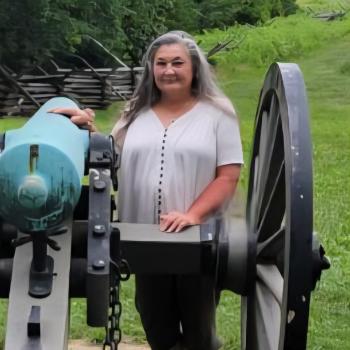
Cabrini: a Film
I realize that I am very late to the party with this review. However, I had to pass along an endorsement for a film about an amazing woman of God. The biopic Cabrini was released on March 8 from Angel Studios and is still playing in selected theaters around the country.
A Non-Catholic Viewpoint
During spring break, Marty and I went to see Cabrini which turned out to be a much more moving experience than I had anticipated, but not entirely in a religious way. First of all, I am not a Catholic; however, I have studied hagiography and read some of the marvelous tales of the saints, I have taught in a Catholic school, and I have many Catholic relatives and friends, some who represent the very best of the religion, and some who represent, well, the other side. When we went to the movie, I suppose I was expecting to see a hagiographic tale, a cloistered mystic receiving direction from God to come to America and start hospitals and orphanages. But as the granddaughter and great granddaughter of Italian immigrants, I was moved to tears many times in the approximately 2 1/2 hours that Cabrini played on the big screen. For the first time, I realized the desperate plight of the immigrants, particularly the orphans. Interestingly enough, we were the only ones in the theater which allowed me some freedom to react.
Italian Immigrants
From my early childhood I remember shadows of conversations and allusions, partly in Italian and partly in English, as my elder relatives discussed the conditions they found when they came to the land of opportunity. The American factories needed workers, and in Italy, young men were promised that if they would only come, jobs would be waiting. In some cases, like with my great grandfather Gerolamo (Jerome) Baldo, that was true. For many others, like my grandfather Joe Carella, “a job waiting” meant getting up before dawn and going to the steel mill and waiting for a shop foreman to come out and announce, “I need a few men to work today,” and point out the ones he wanted for a day or even for just a few hours. True, work was available, but it was not a steady job with reliable hours, and many of those workers had families to support. Many did not speak fluent English. They became the group to receive the brunt of the name-calling and prejudice at the time.
Rod Barr, screenwriter: It’s difficult for us to conceive that Italians were called “brown-skinned animals” and were considered the lowest of the low. One immigrant wrote from New York: “Here we live like animals. We live and die without priests, without teachers, without doctors.” Any good historical resources about Italian immigration will paint a similar picture of desperation. By the way, this is why I wrote that card at the beginning of the movie, which says something like: “Many Americans considered Italians to be of inferior intelligence… And a threat to the very fabric of America.” Without stating this up front as a plain fact, I was concerned that audiences wouldn’t believe it.
The Real Mother Cabrini
The conditions evidenced in the movie were real, and the characters, for the most part, were real. According to the Missionary Sisters of the Sacred Heart of Jesus, Frances Cabrini was born on July 15, 1850 in a small village called S’ant Angelo Lodigiano near the city of Milan, Italy. She was the youngest of thirteen children. She was educated by the Daughters of the Sacred Heart, and through them was able to receive a teaching degree. Although she grew up with a desire to become a missionary, because of her frail health, she was not permitted to join the order.
“However, in 1880, with seven young women, Frances founded the Institute of the Missionary Sisters of the Sacred Heart of Jesus. She was as resourceful as she was prayerful, finding people who would donate what she needed in money, time, labor and support. She and her sisters wanted to be missionaries in China; she visited Rome to obtain an audience with Pope Leo XIII. The Pope told Frances to go ‘not to the East, but to the West’ to New York rather than to China as she had expected. She was to help the thousands of Italian immigrants already in the United States.
“In 1889, New York seemed to be filled with chaos and poverty, and into this new world stepped Mother Frances Cabrini and her sister companions. Cabrini organized catechism and education classes for the Italian immigrants and provided for the needs of the many orphans. She established schools and orphanages despite tremendous odds.
“Soon, requests for her to open schools came to Frances Cabrini from all over the world. She traveled to Europe, Central and South America and throughout the United States. She made 23 trans-Atlantic crossings and established 67 institutions: schools, hospitals and orphanages.”
Mother Cabrini continued her passionate pursuit to serve the Lord until her death. She died in Chicago on December 22, 1917. Pope Pius XII honored her service to God and mankind by having her canonized as a saint (the first American saint) and the Patroness of Immigrants in 1946. The action of the film ends with her death and a map of all the schools, hospitals, and orphanages that she and her order established around the world.
Cabrini Film High Points
Cristiana Dell’Anna gives a stellar performance as Frances Xavier Cabrini. If a little too intense and stern at times (I have read that the woman was quite joyful in real life), she made me believe in the trials and tribulations she faced, and her passion to complete every task. Dell’Anna had me rooting for her while the odds were stacked against her, and “booing” in my heart the authorities of city and church who pulled against her.
It is impossible to discuss this movie without mentioning the musical score. Gene Back composed nearly 100 minutes of fully orchestral film score, which featured some of the greatest talent in the classical world including the Andrea Bocelli family, Rolando Villazon, and Ennio Morricone’s orchestra in Rome. Bocelli’s eleven-year-old daughter made her film debut as a choir singer named Aria. Their duet “Dare to Be” is a featured moment.
Andrea Bocelli, Virginia Bocelli – Dare To Be (From The Motion Picture “Cabrini”)
My three favorite quotes from the film are:
Cabrini: “We can serve our weakness or we can serve our purpose. Not both.”
Cabrini: “It takes a lot of courage to be who we’re meant to be.”
Cabrini: “What kind of world do we want, and what will we do to live in it?”
See It For Yourself
Not all reviews of the film have been top shelf, but famed critic Roger Ebert comments, “[the film] humbly challenges its contemporary viewers to ask themselves what kind of a city, country or world would they want to live in—those that favor a select few and leave everyone else behind, or those founded on values of true equality? Cabrini and her Sisters fiercely believed in the latter, erecting something that should be commemorated in the same breath as what the Rockefellers or the Vanderbilts of the world have accomplished (to paraphrase a journalist who portrays their work in support). Cabrini is in no way a perfect movie, but a damn dignified one that honors the little-known efforts of these fearless women.”
The acting is stellar. Some, not most, of the dialogue is in Italian with subtitles. There is no shocking language other than slurs against people groups, no nudity, some moderate violence. I absolutely recommend this film for teens and above.
Cabrini | The First 19 Minutes | Angel Studios
God bless you and give you passion to live for Him.













